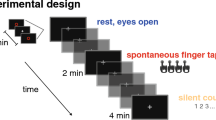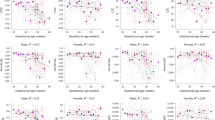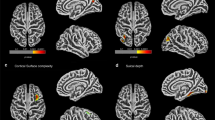Abstract
Resting cortical activity is characterized by a distinct spectral peak in the alpha frequency range. Slowing of this oscillatory peak toward the upper theta-band has been associated with a variety of neurological and neuropsychiatric conditions and has been attributed to altered thalamocortical dynamics. Children born very preterm exhibit altered development of thalamocortical systems. To test the hypothesis that peak oscillatory frequency is slowed in children born very preterm, we recorded resting magnetoencephalography (MEG) from school age children born very preterm (≤32 wk gestation) without major intellectual or neurological impairment and age-matched full-term controls. Very preterm children exhibit a slowing of peak frequency toward the theta-band over bilateral frontal cortex, together with reduced alpha-band power over bilateral frontal and temporal cortex, suggesting that mildly dysrhythmic thalamocortical interactions may contribute to altered spontaneous cortical activity in children born very preterm.
Similar content being viewed by others
Log in or create a free account to read this content
Gain free access to this article, as well as selected content from this journal and more on nature.com
or
Abbreviations
- MEG:
-
magnetoencephalography
References
Behrman RE, Butler AS, Institute of Medicine (U.S.) Committee on Understanding Premature Birth and Assuring Healthy Outcomes 2007 Preterm Birth: Causes, Consequences, and Prevention. National Academies Press, Washington DC,
Roberts G, Anderson PJ, De Luca C, Doyle LW, Victorian Infant Collaborative Study Group 2010 Changes in neurodevelopmental outcome at age eight in geographic cohorts of children born at 22–27 weeks' gestational age during the 1990s. Arch Dis Child Fetal Neonatal Ed 95: F90–F94
Grunau R 2002 Early pain in preterm infants. A model of long-term effects. Clin Perinatol 29: 373–394
Marlow N, Hennessy EM, Bracewell MA, Wolke D 2007 Motor and executive function at 6 years of age after extremely preterm birth. Pediatrics 120: 793–804
Mulder H, Pichford NJ, Haggar MS, Marlow N 2009 Development of executive function and attention in preterm children: a systematic review. Dev Neuropsychol 34: 393–421
Rickards AL, Kelly EA, Doyle LW, Callanan C 2001 Cognition, academic progress, behavior and self-concept at 14 years of very low birth weight children. J Dev Behav Pediatr 22: 11–18
Taylor HG, Minich NM, Klein N, Hack M 2004 Longitudinal outcomes of very low birth weight: neuropsychological findings. J Int Neuropsychol Soc 10: 149–163
Gozzo Y, Vohr B, Lacadie C, Hampson M 2009 Alterations in neural connectivity in preterm children at school age. Neuroimage 48: 458–463
Narberhaus A, Lawrence E, Allin MP, Walshe M, McGuire P, Rifkin L, Murray R, Nostari C 2009 Neural substrates of visual paired associates in young adults with a history of very preterm birth: alterations in fronto-parieto-occipital networks and caudate nucleus. Neuroimage 47: 1884–1893
Schafer RJ, Lacadie C, Vohr B, Kesler SR, Schneider KC, Pugh KR, Makuch RW, Reiss AL, Constable RT, Ment LR 2009 Alterations in functional connectivity for language in prematurely born adolescents. Brain 132: 661–670
Peterson BS, Vohr B, Staib LH, Cannistraci BA, Dolberg A, Katz KH, Westerveld M, Sparrow S, Anderson AW, Duncan CC, Makuch RW, Gore JC, Ment LR 2000 Regional brain volume abnormalities and long-term cognitive outcome in preterm infants. JAMA 284: 1939–1947
Hart AR, Whitby EW, Griffiths PD, Smith MF 2008 Magnetic resonance imaging and developmental outcome following preterm birth: review of current evidence. Dev Med Child Neurol 50: 655–663
Ment LR, Hirtz D, Hüppi PS 2009 Imaging of biomarkers of outcome in the developing preterm brain. Lancet Neurol 8: 1042–1055
Uhlhaas PJ, Pipa G, Lima B, Melloni L, Neuenschwander S, Nikolić D, Singer W 2009 Neural synchrony in cortical networks: history, concept and current status. Front Integr Neurosci 3: 17
Varela F, Lachaux JP, Rodriguez E, Martinerie J 2001 The brainweb: phase synchronization and large-scale integration. Nat Rev Neurosci 2: 229–239
Ward LM 2003 Synchronous neural oscillations and cognitive processes. Trends Cogn Sci 7: 553–559
Benasich AA, Gou Z, Choudhury N, Harris KD 2008 Early cognitive and language skills are linked to resting frontal gamma power across the first 3 years. Behav Brain Res 195: 215–222
Uhlhaas PJ, Roux F, Singer W, Heanschel C, Sieteanu R, Rodriguez E 2009 The development of neural synchrony reflects late maturation and restructuring of functional networks in humans. Proc Natl Acad Sci U S A 106: 9866–9871
Ribary U 2005 Dynamics of thalamo-cortical network oscillations and human perception. Prog Brain Res 150: 127–142
Dudink J, Kerr JL, Paterson K, Counsell SJ 2008 Connecting the developing preterm brain. Early Hum Dev 84: 777–782
Miller SP, Ferriero DM 2009 From selective vulnerability to connectivity: insights from newborn brain imaging. Trends Neurosci 32: 496–505
Anjari M, Srinivasan L, Allsop JM, Hajnal JV, Rutherford MA, Edwards AD, Counsell SJ 2007 Diffusion tensor imaging with tract-based spatial statistics reveals local white matter abnormalities inpreterm infants. Neuroimage 35: 1021–1027
Dudink J, Maarten L, van Pul C, Buijs J 2007 Fractional anisotropy in white matter tracts of very-low-birth-weight infants. Pediatr Radiol 37: 1216–1223
Kostovic I, Rakic P 1990 Developmental history of the transient subplate zone in the visual and somatosensory cortex of the macaque monkey and human brain. J Comp Neurol 297: 441–470
Allendoerfer KL, Shatz CJ 1994 The subplate, a transient neocortical structure: its role in the development of connections between thalamus and cortex. Annu Rev Neurosci 17: 185–218
Kostovic I, Jovanov-Milosević N 2006 Development of cerebral connections during the first 20–45 weeks' gestation. Semin Fetal Neonatal Med 11: 415–422
Smyser CD, Inder TE, Shimony JS, Hill JE, Degnan AJ, Snyder AZ, Neil JJ 2010 Longitudinal analysis of neural network development in preterm infants. Cereb Cortex 20: 2852–2862
Llinás RR, Ribary U, Jeanmonod D, Kronberg E, Mitra PP 1999 Thalamocortical dysrhythmia: a neurological and neuropsychiatric syndrome characterized by magnetoengephlography. Proc Natl Acad Sci U S A 96: 15222–15227
Marini G, Ceccarelli P, Mancia M 2002 Thalamocortical dysrhythmia and the thalamic reticular nucleus in behaving rats. Clin Neurophysiol 113: 1152–1164
Hughes SW, Crunelli V 2005 Thalamic mechanisms of EEG alpha rhythms and their pathological implications. Neuroscientist 11: 357–372
Steriade M 2006 Grouping of brain rhythms in corticothalamic systems. Neuroscience 137: 1087–1106
Boord P, Siddall PJ, Tran Y, Herbert D, Middleton J, Craig A 2008 Electroencephalographic slowing and reduced reactivity in neuropathic pain following spinal cord injury. Spinal Cord 46: 118–123
Boutros NN, Arfken C, Galderisi S, Warrick J, Pratt G, Iacono W 2008 The status of spectral EEG abnormality as a diagnostic test for schizophrenia. Schizophr Res 99: 225–237
Jeong J 2004 EEG dynamics in patients with Alzheimer's disease. Clin Neurophysiol 115: 1490–1505
Moazami-Goudarzi M, Sarnthein J, Michels L, Moukhtieva R, Jeanmonod D 2008 Enhanced frontal low and high frequency power synchronization in the resting EEG of Parkinsonian patients. Neuroimage 41: 985–997
Sarnthein J, Stern J, Aufenberg C, Rousson V, Jeanmonod D 2006 Increased EEG power and slowed dominant frequency in patients with neurogenic pain. Brain 129: 55–64
Sarnthein J, Jeanmonod D 2007 High thalamocortical coherence in patients with Parkinson's disease. J Neurosci 27: 124–131
Sarnthein J, Jeanmonod D 2008 High thalamocortical coherence in patients with neurogenic pain. Neuroimage 39: 1910–1917
Cauda F, Sacco K, D'Agata F, Duca S, Cocito D, Geminiani G, Migliorati F, Isoardo G 2009 Low-frequency BOLD fluctuations demonstrate altered thalamocortical connectivity in diabetic neuropathic pain. BMC Neurosci 10: 138
Sarnthein J, Morel A, von Stein A, Jeanmonod D 2005 Thalamocortical theta coherence in neurological patients at rest and during a working memory task. Int J Psychophysiol 57: 87–96
Welsh RC, Chen AC, Taylor SF 2010 Low-frequency BOLD fluctuations demonstrate altered thalamocortical connectivity in schizophrenia. Schizophr Bull 36: 713–722
Valdés-Hernández PA, Ojeda-Gonzalez A, Martinez-Montes E, Lage-Castellanos A, Virués-Alba T, Valdés-Urrutia L, Valdes-Sosa PA 2010 White matter architecture rather than cortical surface area correlated with the EEG alpha rhythm. Neuroimage 49: 2328–2339
Grunau RE, Haley DW, Whitfield MF, Weinberg J, Yu W, Thiessen P 2007 Altered basal cortisol levels at 3, 6, 8 and 18 months in infants born at extremely low gestational age. J Pediatr 150: 151–156
Grunau RE, Whitfield MF, Petrie-Thomas J, Synnes AR, Cepeda IL, Keidar A, Rogers M, Mackay M, Hubber-Richard P, Johannesen D 2009 Neonatal pain, parenting stress and interaction, in relation to cognitive and motor development at 8 and 18 months in preterm infants. Pain 143: 138–146
Wechsler D 2003 Wechsler Intelligence Scales for Children: 4th ed. (WISC-IV). Psychological Corporation, San Antonio, TX,
Papile LA, Burstein J, Burstein R, Koffler H 1978 Incidence and evolution of subependymal and intraventricular hemorrhage: a study of infants with birth weights less than 1500 grams. J Pediatr 92: 529–534
Doesburg SM, Ribary U, Herdman AT, Miller SP, Poskitt KJ, Moiseev A, Whitfield MF, Synnes A, Grunau RE 2011 Altered long-range alpha-band synchronization during visual short-term memory retention in children born very preterm. Neuroimage 54: 2330–2339
Wilson H, Moiseev A, Podin S, Quraan M 2007 Continuous head localization and data correction in MEG. Int Congress Ser 1300: 623–626
Herdman AT, Cheyne D 2009 A practical guide to MEG and beamforming. In: Handy TC (eds) Brain Signal Analysis: Advances in Neuroelectric and Neuromagnetic Methods. MIT Press, Cambridge, pp 99–140
Bastiaansen MC, Knosche TR 2000 Tangential derivative mapping of axial MEG applied to event-related desynchronization research. Clin Neurophysiol 111: 1300–1305
Mazaheri A, Nieuwenhuis IL, van Dijk H, Jensen O 2009 Prestimulus alpha and mu activity predicts failure to inhibit motor responses. Hum Brain Mapp 30: 1791–1800
Doesburg SM, Green JJ, McDonald JJ, Ward LM 2009 Rhythms of consciousness: binocular rivalry reveals large-scale oscillatory network dynamics mediating visual perception. PLoS One 4: e6142
Kitajo K, Doesburg SM, Yamanaka K, Nozaki D, Ward LM, Yamamoto Y 2007 Noise-induced large-scale phase synchronization of human-brain activity associated with behavioural stochastic resonance. Europhys Lett 80: 40009
Stoffers D, Bosboom JL, Deijen JB, Wolters EC, Stam CJ, Berendse HW 2008 Increased cortico-cortical functional connectivity in early-stage Parkinson's disease: an MEG study. Neuroimage 41: 212–222
Stoffers D, Bosboom JL, Wolters EC, Stam CJ, Berendse HW 2008 Dopaminergic molulation of cortico-cortical functional connectivity in Parkinson's disease: an MEG study. Exp Neurol 213: 191–195
Taylor MJ, Saliba E, Laugier J 1996 Use of evoked potentials in preterm neonates. Arch Dis Child Fetal Neonatal Ed 74: F70–F76
Fellman V, Kushnerenko E, Mikkola K, Ceponiene R, Leipala J, Naatanen R 2004 Atypical auditory event-related potentials in preterm infants during the first year of life: a possible sign of cognitive dysfunction?. Pediatr Res 56: 291–297
Gomot M, Bruneau N, Laurent JP, Barthélémy C, Sabilia E 2007 Left temporal impairment of auditory information processing in prematurely born 9-year-old children: an electrophysiological study. Int J Psychophysiol 64: 123–129
O'Reilly M, Vollmer B, Vargha-Khadem F, Neville B, Connelly A, Wyatt J, Timms C, de Haan M 2010 Opthamological, cognitive, electrophysiological and MRI assessment of visual processing in preterm children without major neuromotor impairment. Dev Sci 13: 692–705
Klimesch W, Sauseng P, Hanslmayr S 2007 EEG alpha oscillations: the inhibition-timing hypothesis. Brian Res Rev 53: 63–88
Palva S, Palva JM 2007 New vistas for alpha-frequency band oscillations. Trends Neurosci 30: 150–158
Krause CM, Salminen PA, Sillanmaki L, Holopainen IE 2001 Event related desynchronization and synchronization during a memory task in children. Clin Neurophysiol 112: 2233–2240
Xiang J, Liu Y, Wang Y, Kotecha R, Kirtman EG, Huo X, Fujiwara H, Hemasilpin N, DeGrauw T, Rose M 2009 Neuromagnetic correlated of developmental changes in endogenous high-frequency brain oscillations in children: a wavelet-based beamformer study. Brain Res 1274: 28–39
Yordanova J, Kolev V 1997 Alpha response system in children: changes with age. Int J Psychophysiol 26: 411–430
Okumura A, Kubota T, Tsuji T, Kato T, Hayakawa F, Watanabe K 2006 Amplitude spectral analysis of theta/alpha/beta waves in preterm infants. Pediatr Neurol 34: 30–34
Vanhatalo S, Kaila K 2006 Development of neonatal EEG activity: from phenomenology to physiology. Semin Fetal Neonatal Med 11: 471–478
Grieve PG, Isler JR, Izraelit A, Peterson BS, Fifer WP, Myers MM, Stark RI 2008 EEG functional connectivity in term age extremely low birth weight infants. Clin Neurophysiol 119: 2712–2720
Clarke AR, Barry RJ, McCarthy R, Selikowitz M 2001 Age and sex effects in the EEG: development of the normal child. Clin Neurophysiol 112: 806–814
Gasser T, Jennen-Steinmetz C, Stroka L, Verleger R, Möcks J 1988 Development of the EEG of school-age children and adolescents. II. Topography. Electroencephalogr Clin Neurophysiol 69: 100–109
Miskovic V, Schmidt LA, Boyle M, Saigal S 2009 Regional electroencephalogram (EEG) spectral power and hemispheric coherence in young adults born at extremely low birth weight. Clin Neurophysiol 120: 231–238
Grunau RE, Holsti L, Peters JW 2006 Long-term consequences of pain in human neonates. Semin Fetal Neonatal Med 11: 268–275
Okumura A, Kubota T, Toyota N, Kidokoro H, Maruyama K, Kato T, Hayakawa F, Watanabe K 2003 Amplitude spectral analysis of maturational changes in delta waves in preterm infants. Brain Dev 25: 406–410
Tolonen M, Palva JM, Andersson S, Vanhatalo S 2007 Development of the spontaneous activity transients and ongoing cortical activity in human preterm babies. Neuroscience 145: 997–1006
Acknowledgements
We thank Dr. Ivan Cepeda and Gisela Gosse for coordinating the study, and Katia Jitlina and Amanda Degenhardt for their help in data collection. We thank Diederick Stoffers for help with figures.
Author information
Authors and Affiliations
Corresponding author
Additional information
Supported by grant RO1 HD039783 from the Kennedy Shriver Institute of Child Health and Human Development (NICHD/NIH) [R.E.G.], the Michael Smith Foundation for Health Research [S.M.D.], the Child and Family Research Institute [S.M.D., R.E.G.], The Canadian Institutes for Health Research [S.M.D., R.E.G., S.P.M.], the Human Early Learning Partnership [R.E.G.], and the BC Leading Edge Endowment Fund [U.R.].
Rights and permissions
About this article
Cite this article
Doesburg, S., Ribary, U., Herdman, A. et al. Magnetoencephalography Reveals Slowing of Resting Peak Oscillatory Frequency in Children Born Very Preterm. Pediatr Res 70, 171–175 (2011). https://doi.org/10.1203/PDR.0b013e3182225a9e
Received:
Accepted:
Issue date:
DOI: https://doi.org/10.1203/PDR.0b013e3182225a9e
This article is cited by
-
Combining advanced MRI and EEG techniques better explains long-term motor outcome after very preterm birth
Pediatric Research (2022)
-
Altered Network Oscillations and Functional Connectivity Dynamics in Children Born Very Preterm
Brain Topography (2015)
-
Modulation of EEG spectral edge frequency during patterned pneumatic oral stimulation in preterm infants
Pediatric Research (2014)



